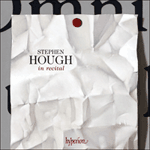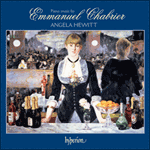
Welcome to Hyperion Records, a British classical label devoted to presenting high-quality recordings of music of all styles and from all periods from the twelfth century to the twenty-first.
Hyperion offers both CDs, and downloads in a number of formats. The site is also available in several languages.
Please use the dropdown buttons to set your preferred options, or use the checkbox to accept the defaults.

| Sir Stephen Hough (piano)» More |
from notes by Gerald Larner © 2009
extrait des notes rédigées par Gerald Larner © 2009
Français: Hypérion
aus dem Begleittext von Gerald Larner © 2009
Deutsch: Viola Scheffel
 Stephen Hough in recital Stephen Hough in recitalThe Hough discography is enhanced by this delightful recital disc from the winner of the Gramophone Gold Disc Award, acclaimed recently as ‘Britain’s finest pianist’ (The Sunday Times), and as one of the six greatest pianists performing in the wor ...» More |
 Chabrier: Piano Music Chabrier: Piano Music |

